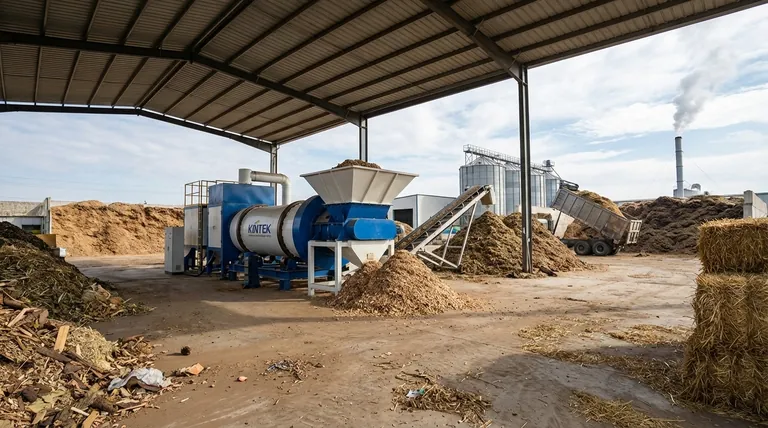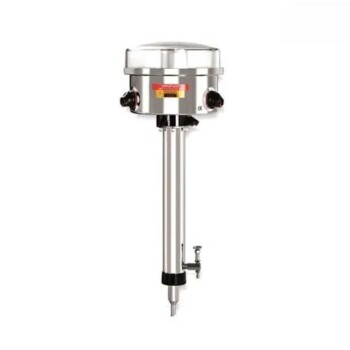To state a single cost for biomass energy is misleading. The price is highly variable, but for utility-scale projects, the Levelized Cost of Energy (LCOE) typically ranges from $0.06 to $0.15 per kilowatt-hour (kWh). This cost is fundamentally driven by the type of raw material (feedstock) used, its proximity to the power plant, and the technology used for conversion.
The central takeaway is that the economic viability of biomass energy depends less on technological breakthroughs and more on mastering local supply chain logistics. Unlike solar or wind, where the "fuel" is free, the cost of acquiring, transporting, and processing biomass feedstock constitutes the largest and most volatile portion of its total expense.

Deconstructing the Cost of Biomass Energy
To accurately assess the cost, you must break it down into its core components. Each element can vary dramatically based on the specific project, location, and scale.
The Dominant Factor: Feedstock Costs
The price of the raw organic material is the single most significant driver of the final energy cost, often accounting for over half of the total operational expense.
Feedstock sources range from agricultural crop residues and dedicated energy crops to forest products and municipal solid waste. The most economical projects utilize low-cost or negative-cost materials, such as industrial waste streams.
Logistics and Transportation
Biomass is bulky and has a low energy density compared to fossil fuels, making transportation a major cost center. The economic viability of a plant is often determined by its proximity to a consistent and abundant feedstock source.
This "tyranny of distance" means that a plant's entire supply chain must be optimized within a relatively small geographic radius, typically 50-100 miles.
Capital Costs (CAPEX)
This is the upfront investment required to build the facility. The cost varies based on the conversion technology used.
Direct combustion plants are the most common and mature technology. More advanced methods like gasification or anaerobic digestion can have different capital requirements and produce different outputs, such as biogas or syngas.
Operational and Maintenance Costs (O&M)
These are the ongoing expenses required to run the plant. O&M includes labor, routine maintenance, parts replacement, and compliance with environmental regulations.
While O&M costs are typically lower than feedstock costs, they are a consistent and critical part of the LCOE calculation.
Understanding the Trade-offs and Challenges
Biomass energy is not without its economic and operational complexities. Recognizing these trade-offs is crucial for an objective evaluation.
The Challenge of Scale
Due to feedstock and logistical constraints, biomass plants are generally smaller than large-scale coal or natural gas plants. This limits their ability to achieve the same economies of scale, which can result in a higher per-unit cost of energy.
Feedstock Price Volatility
The price of biomass feedstock is subject to market forces. Competition for the same materials (e.g., wood for lumber vs. energy) or poor harvests can lead to significant price fluctuations, creating financial risk for the power plant operator.
Sustainability and Land Use
While biomass from waste streams is widely considered sustainable, using dedicated energy crops can raise "food vs. fuel" concerns. The sourcing of feedstock must be carefully managed to ensure it doesn't lead to negative environmental outcomes like deforestation or soil degradation.
Comparing Biomass to Other Energy Sources
The true value of biomass becomes clear when you compare its unique characteristics, not just its price, against other generation technologies.
The Key Advantage: Dispatchability
Unlike intermittent renewables like solar and wind, biomass is a dispatchable energy source. This means it can generate power on demand, 24/7, just like a fossil fuel plant.
This reliability allows it to provide stable, baseload power to the grid, making it a valuable tool for complementing and balancing the variability of other renewables.
Cost Competitiveness
In regions with abundant, low-cost feedstock (such as the forestry or agricultural sectors), biomass can be cost-competitive with fossil fuels, especially when carbon taxes or emissions regulations are in place.
However, in many markets, its LCOE remains higher than new utility-scale solar or wind projects, which benefit from zero fuel cost.
The Role of Incentives and Policy
The final economic calculation for a biomass project is heavily influenced by government policy. Renewable energy credits, tax incentives, and carbon pricing can significantly improve its financial viability and make it an attractive investment.
Making the Right Choice for Your Goal
The decision to use biomass energy should be based on your specific strategic objectives.
- If your primary focus is stable, baseload renewable power: Biomass is one of the few renewable options that can provide reliable, on-demand electricity to stabilize the grid.
- If your primary focus is waste reduction: Biomass is an excellent solution for industries like forestry, farming, or food processing to convert organic waste streams into valuable energy.
- If your primary focus is the absolute lowest cost per kWh: Utility-scale solar and wind are often cheaper in ideal locations, but they lack the dispatchability that biomass provides.
Ultimately, evaluating biomass requires a localized analysis of the feedstock supply chain, as this factor will define its cost and success more than any other.
Summary Table:
| Cost Factor | Description | Impact on LCOE |
|---|---|---|
| Feedstock | Cost of raw organic material (e.g., crop residue, wood waste). | Largest & most volatile cost driver (>50% of Opex). |
| Logistics | Transportation of bulky, low-energy-density biomass. | High cost; viability depends on proximity to source (<100 miles). |
| Capital (CAPEX) | Upfront cost of plant construction (combustion, gasification). | Varies by technology; direct combustion is most common. |
| O&M (Operational) | Labor, maintenance, and regulatory compliance. | Consistent, secondary cost component. |
| Key Advantage | Dispatchability: Provides on-demand, baseload power unlike solar/wind. | Adds value for grid stability. |
Optimize Your Biomass Energy or Laboratory Process with KINTEK
Whether you are developing a biomass energy project and need reliable equipment for feedstock processing and analysis, or you are operating a laboratory that supports such initiatives, KINTEK is your trusted partner. We specialize in high-quality lab equipment and consumables that are essential for:
- Feedstock Analysis: Accurately characterizing biomass composition and energy content.
- Process Development: Testing and scaling up conversion technologies like pyrolysis or gasification.
- Quality Control: Ensuring consistent output and operational efficiency for your plant or research.
By partnering with KINTEK, you gain access to durable, precise tools that enhance the reliability and accuracy of your work, helping you master the supply chain logistics that are critical to biomass energy's economic success.
Contact us today to discuss how our solutions can support your specific biomass or laboratory needs. Let's build a more sustainable and efficient energy future together.
Visual Guide

Related Products
- Electric Rotary Kiln Small Rotary Furnace Biomass Pyrolysis Plant
- Electric Rotary Kiln Small Rotary Furnace for Activated Carbon Regeneration
- Electric Rotary Kiln Continuous Working Small Rotary Furnace Heating Pyrolysis Plant
- Electric Rotary Kiln Pyrolysis Furnace Plant Machine Calciner Small Rotary Kiln Rotating Furnace
- Wall Mounted Water Distillation Unit
People Also Ask
- What are the products of pyrolysis of biomass? Unlock Bio-Char, Bio-Oil, and Syngas
- How is energy converted into biomass? Harnessing Nature's Solar Power for Renewable Energy
- What is the process of biomass fast pyrolysis? Turn Biomass into Bio-Oil in Seconds
- Is pyrolysis viable? A Guide to Economic, Technological, and Environmental Success
- What are the different types of pyrolysis machines? Choose the Right System for Your Output










